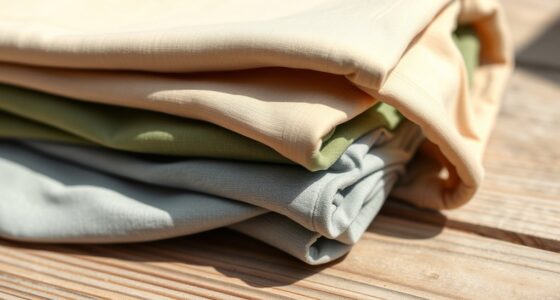If you’re searching for fun and eco-friendly water-saving experiment kits, I’ve found some great options that teach kids about water conservation through hands-on activities. These kits cover water filtration, desalination, renewable energy, and conservation techniques, suitable for various ages. They include durable, safe materials and engaging experiments that make learning about water sustainability both easy and exciting. Keep exploring to discover which kits are best for fostering eco-conscious habits and scientific curiosity.
Key Takeaways
- These kits demonstrate water conservation techniques like filtration, recycling, and rainwater harvesting through hands-on experiments suitable for kids.
- They promote eco-friendly learning by illustrating sustainable practices such as desalination, water purification, and renewable energy use.
- Designed for various age groups, these kits make complex water-saving concepts engaging and accessible for children 3 and up.
- Many include reusable components and household activities to encourage ongoing water-saving habits at home and in the classroom.
- They combine fun experiments with environmental education, fostering curiosity, critical thinking, and responsibility about water conservation.
4M Clean Water Science Educational STEM Toy for Kids & Teens

Are you looking for an engaging way to teach kids about water conservation and science? The 4M Clean Water Science STEM toy is perfect for young learners aged 8 and up. It offers hands-on experience in extracting salt from seawater, demonstrating desalination and water purification techniques. The kit includes a plastic filter system, active carbon, sand, rock, and filter paper, making experiments both fun and educational. It encourages exploration of environmental issues like climate change and global warming. Plus, the clear instructions guarantee safe, effective learning. This toy sparks curiosity about science and promotes awareness of water-related environmental challenges.
Best For: young science enthusiasts aged 8 and above who are interested in environmental science, water conservation, and hands-on STEM learning.
Pros:
- Encourages hands-on experimentation with desalination and water purification techniques.
- Promotes awareness of environmental issues such as climate change and global warming.
- Includes comprehensive instructions ensuring safe and effective use.
Cons:
- May require adult supervision for younger children during experiments.
- Limited to basic desalination techniques, which might not cover more advanced water treatment processes.
- The kit components may need replacement or additional materials for extended use.
Learning Resources Splashology Water Lab Science Kit

The Learning Resources Splashology Water Lab Science Kit is an excellent choice for parents and educators looking to introduce young children to STEM concepts through hands-on water play. I love how it combines fun with learning, offering activities like pouring, floating, and bubble creation that teach volume, buoyancy, and flow. The set’s durable plastic and foam pieces are reusable and safe, making water experiments easy and mess-free. With guided and open-ended experiments, kids become little scientists, exploring independently or with supervision. It’s perfect for bath time or water tables, making science engaging while fostering curiosity and fine motor skills.
Best For: parents, educators, and caregivers seeking a durable, educational water science kit to engage children ages 3 and up in hands-on STEM learning through water play.
Pros:
- Encourages STEM learning concepts like buoyancy, volume, and flow through fun experiments
- Durable, reusable, and washable plastic and foam components for long-term use
- Suitable for guided and open-ended play in bathtubs, sinks, or water tables
Cons:
- Some users suggest additional storage solutions for parts to keep organized
- May benefit from more experiment accessories or activities included in the set
- Designed for children up to 6 years old, so older kids may find it less challenging
Thames & Kosmos Water Power STEM Experiment Kit

If you’re looking for a hands-on way to teach kids about physics concepts like action-reaction and rocket propulsion, the Thames & Kosmos Water Power STEM Experiment Kit is an excellent choice. It lets kids build six different models, including water-rocket cars, jet-propelled boats, water guns, and lawn sprinklers. The kit includes a full-color manual and experiment guide, making instructions easy to follow. Through practical building and experimentation, children learn about compressed air, pneumatics, and natural rocket principles. Perfect for outdoor fun, this kit makes physics engaging and accessible, encouraging curiosity and exploration in a lively, splashy way.
Best For: educators, parents, and kids interested in hands-on science experiments to explore physics principles through engaging outdoor activities.
Pros:
- Encourages active learning with six different air-and-water powered models.
- Includes a detailed, full-color manual and experiment guide for easy instruction.
- Promotes understanding of complex physics concepts like action-reaction and pneumatics in a fun, splashy way.
Cons:
- Requires outdoor space for some models, which may not be suitable for all environments.
- Assembly of models may be challenging for very young children without adult supervision.
- Limited to water and air propulsion models, so less suitable for broader science topics.
Thames & Kosmos Hydropower Science Kit

Looking for an engaging way to introduce kids to renewable energy concepts? The Thames & Kosmos Hydropower Science Kit offers 12 hands-on experiments that teach children how water can generate electricity and mechanical work. It demonstrates water turbines, pressure, and properties like surface tension, helping kids understand hydroelectric dams and tidal power. They can build models like waterwheels, hydroelectric stations, and water towers, learning how moving water produces energy. The detailed manual combines scientific explanations with fun activities, making complex concepts accessible for ages 8 and up. It’s perfect for sparking curiosity about sustainable energy and environmental science in a practical, memorable way.
Best For: educators, parents, and science enthusiasts interested in teaching or learning about renewable energy and environmental science through hands-on experiments.
Pros:
- Engaging, hands-on activities that make complex scientific concepts accessible for children aged 8 and up
- Includes a comprehensive, illustrated manual with detailed explanations and instructions
- Promotes awareness of sustainable energy sources and environmental science in a fun, memorable way
Cons:
- Some parts may not fit together perfectly or can fall apart during assembly
- A few experiments require additional parts not included in the kit
- Younger children may find certain assembly steps challenging or require adult assistance
Water Filter DIY Kit for Kids

Are you searching for a fun and educational way to introduce kids to science? The Water Filter DIY Kit for Kids is perfect for ages 9-12, offering a hands-on experience in water purification. With materials like pebbles, sand, and filter paper, kids can build their own filtration system using clear step-by-step instructions. This kit helps children understand how water gets cleaned in real life, promoting critical thinking and creativity. Whether at home or in the classroom, it’s an engaging way to teach environmental science while making learning both fun and meaningful. Plus, it encourages curiosity about protecting our water resources.
Best For: parents, teachers, and homeschoolers looking for an engaging, educational STEM activity for children ages 9-12 to learn about water purification through hands-on experimentation.
Pros:
- Encourages active learning and critical thinking with a straightforward, hands-on water filtration project
- Includes all necessary components and clear instructions for easy setup at home or in the classroom
- Promotes environmental awareness and curiosity about water treatment and science concepts
Cons:
- Limited to children within the 8-12 age range, may not be suitable for younger or older students without modification
- Requires access to water and a clean workspace, which might be a consideration in certain environments
- The kit may need additional supervision or guidance for younger children to ensure safe and proper use
4M Green Science: Clean Water Science Kit
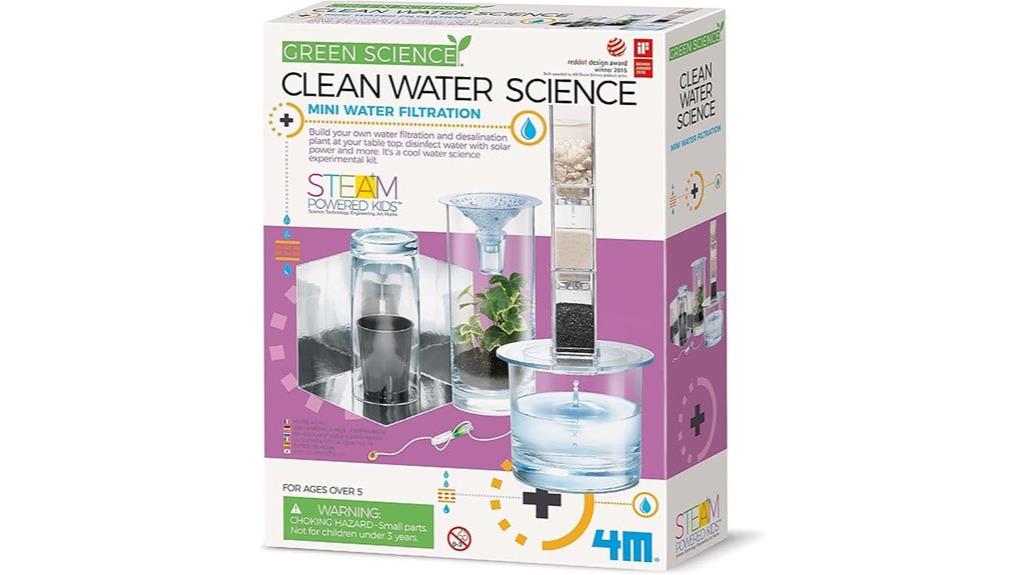
The M Green Science: Clean Water Science Kit is an excellent choice for children aged 5 and up who want to explore water purification through hands-on experiments. With this kit, kids can build their own water filtration and distillation plant, gaining a practical understanding of how clean water is produced. It also highlights solar-powered disinfection techniques, teaching kids about sustainable water management. The included booklet offers engaging experiments that reinforce STEM principles and environmental awareness. All materials are safe and easy to use, making it simple for children to learn about water conservation while having fun. It’s a perfect way to promote eco-friendly habits early on.
Best For: children aged 5 and up interested in learning about water purification, sustainability, and STEM through hands-on experiments and eco-friendly practices.
Pros:
- Engages children with fun, hands-on water filtration and distillation activities.
- Teaches sustainable water management techniques using solar energy.
- Includes a comprehensive booklet with experiments that reinforce STEM concepts and environmental awareness.
Cons:
- Some older children or advanced learners might find the experiments too simple.
- Requires adult supervision for younger children to ensure safety.
- Limited to basic water science concepts; may need additional materials for in-depth exploration.
Bacteria Test Kits for Drinking Water

If you want a reliable and easy way to test your drinking water for bacteria, this bacteria test kit is an excellent choice. It comes with everything you need—culture plates, sterile swabs, gloves, labels, and instructions—so you can test tap, well, or outdoor water sources yourself. Unlike simple test strips, it visually shows bacterial growth within 24-48 hours, making results more accurate. You can identify harmful bacteria like E.coli, Salmonella, and others, and even send photos for free professional analysis if needed. This kit provides peace of mind and helps ensure your water is safe, making water testing straightforward and educational.
Best For: Homeowners, outdoor enthusiasts, and camping or RV users seeking reliable, DIY water testing to ensure safe drinking water from various sources.
Pros:
- Visually detects bacterial growth within 24-48 hours for quick, reliable results
- Includes all necessary supplies for easy, at-home testing without additional equipment
- Allows for professional free analysis by sending photos, ensuring accurate bacterial identification
Cons:
- Petri dishes are not individually wrapped, which could lead to contamination if stored improperly
- Requires careful handling and interpretation of results, which may be challenging for beginners
- Slightly longer wait time compared to instant color-changing test strips, with results taking up to two days
Magic Water Toy Elf Kit with Water Gels and Molds for Kids
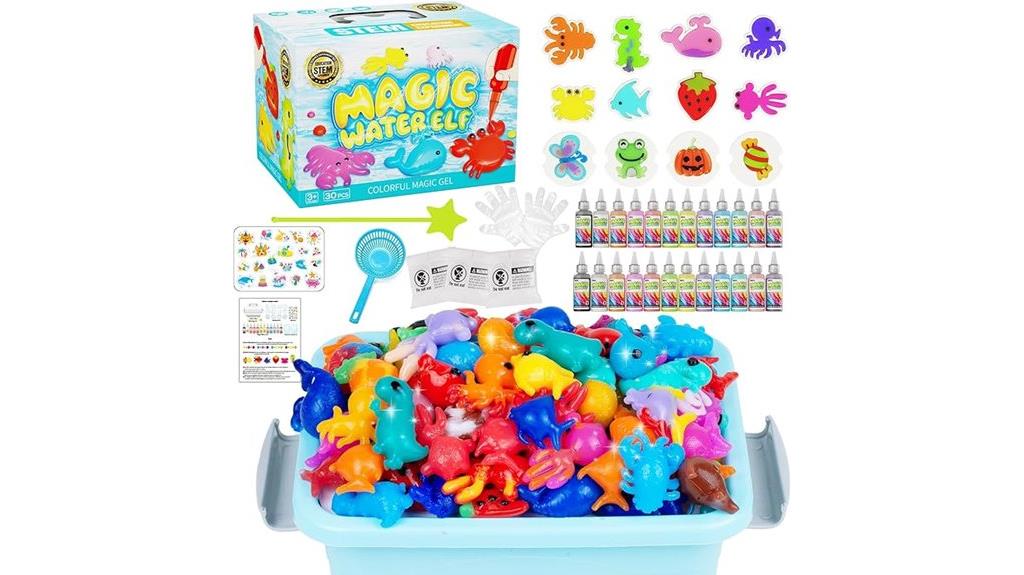
Looking for a fun and educational craft that sparks creativity in children aged 3 to 12? The Magic Water Toy Elf Kit with Water Gels and Molds is perfect. It includes 12 animal molds, vibrant color gels, shape molds, magic powder, and tools, allowing kids to create squishy water pets and toys. The non-toxic, eco-friendly materials are safe and encourage sensory exploration, shape recognition, and fine motor skills. Kids can craft, store, and play with their water creatures, making it ideal for birthdays, holidays, or classroom activities. This mess-free, imaginative kit promotes STEM learning while providing hours of safe, hands-on fun.
Best For: children aged 3-12 who enjoy creative, sensory, and educational craft activities that promote STEM learning and imaginative play.
Pros:
- Encourages creativity, fine motor skills, and shape recognition through hands-on crafting.
- Made from non-toxic, eco-friendly materials, ensuring safe and mess-free play.
- Includes a variety of molds, colors, and tools, providing ample options for imaginative water toy creation.
Cons:
- Requires a waiting time of 10-20 minutes for the magic gel to solidify, which might test young children’s patience.
- Some small parts, like molds and tools, could pose a choking hazard for very young children without supervision.
- May need parent assistance for younger children to ensure proper use and safety during the crafting process.
Crayola Liquid Science Kit for Kids
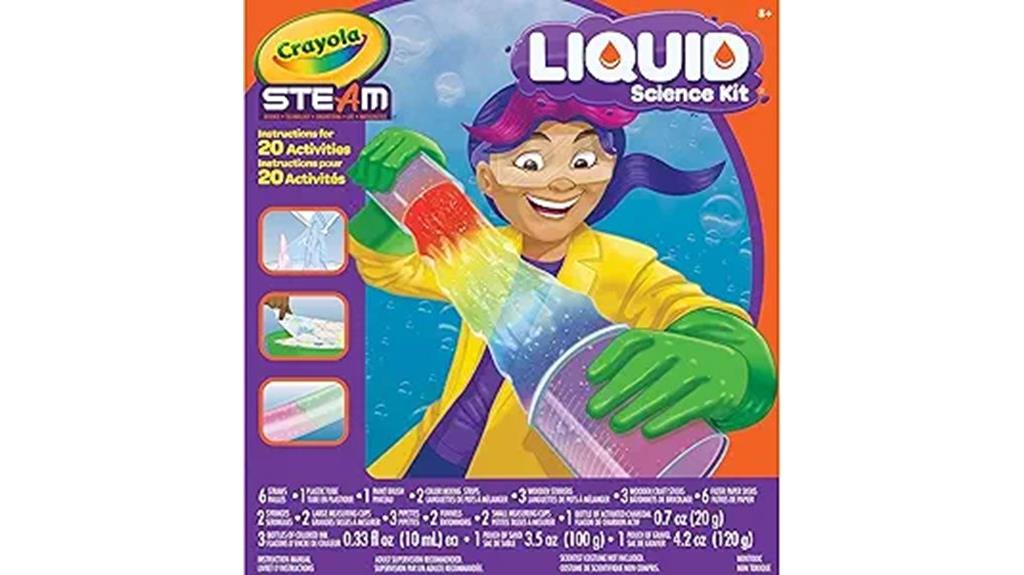
Designed for children ages 7 to 10, the Crayola Liquid Science Kit for Kids is perfect for young learners keen to explore science through hands-on experiments. It includes supplies for 15 water-based labs using common household items, making science fun and accessible. Kids can perform a variety of experiments that support STEM and STEAM learning, encouraging curiosity and understanding. The kit comes with easy, full-color instructions suitable for children, with adult supervision recommended for safety. It’s an excellent gift that promotes at-home scientific exploration, helping kids develop critical thinking skills while having fun with water and basic materials.
Best For: young children aged 7 to 10 who are interested in exploring science through fun, hands-on experiments at home.
Pros:
- Engages kids with 15 easy-to-follow water-based science labs using common household items
- Supports STEM and STEAM learning, fostering curiosity and scientific understanding
- Comes with colorful, step-by-step instructions suitable for children, promoting independent exploration
Cons:
- Adult supervision is recommended for safety during experiments, which may require parental involvement
- Limited to water-based experiments, which might not appeal to children interested in other scientific fields
- The kit may require additional household supplies not included in the box for some experiments
UNGLINGA Science Kits for Kids
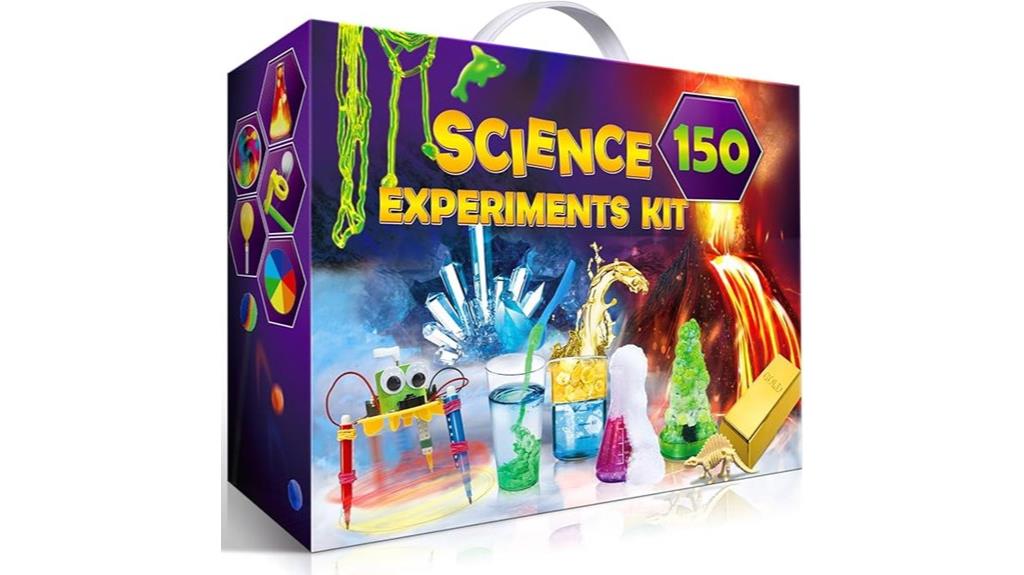
Are you searching for an engaging way to teach kids about sustainability and water conservation? The UNGLINGA Science Kits for Kids make learning science fun and hands-on with 150 experiments covering volcanoes, chemistry, physics, and earth science. Designed for children 8 and up, it encourages curiosity, creativity, and independent exploration. The kit includes high-quality tools, kid-friendly materials, and a clear manual, making experiments easy and enjoyable. It’s perfect for fostering scientific thinking, problem-solving, and motor skills. Whether as a gift or activity, this kit offers hours of educational entertainment, helping kids understand important concepts while having fun.
Best For: parents, teachers, and children aged 8 and above who are interested in engaging, educational science activities that promote curiosity, creativity, and hands-on learning.
Pros:
- Offers 150 diverse experiments covering volcanoes, chemistry, physics, and earth science topics
- Includes high-quality tools and kid-friendly materials for safe and easy experimentation
- Encourages independent exploration, problem-solving, and scientific thinking in children
Cons:
- Some users may experience missing items or packaging issues during shipping
- Instructions could be clearer or better translated for non-English speakers
- Color coding and labeling of materials might be confusing for some children or parents
PlayMonster Science4you Water Science Activity for Kids

If you’re seeking an engaging science kit that makes water education fun and accessible for children aged 6 and up, the PlayMonster Science4you Water Science Activity is an excellent choice. It offers 23 hands-on experiments that teach kids about water through activities like creating giant bubbles, turning cups upside down without spilling, and making tornadoes. The kit includes most supplies needed, plus a detailed 36-page guide with fun facts and safety tips. Kids will develop curiosity, experimentation skills, and a love for science while having fun. It’s a great way to foster learning and discovery in a safe, interactive way.
Best For: children aged 6 and up who are interested in hands-on water science experiments that combine fun and learning.
Pros:
- Offers 23 engaging, hands-on activities that foster curiosity and experimentation
- Includes a detailed 36-page full-color learning guide with fun facts and safety instructions
- Encourages cognitive development and a positive attitude toward science through enjoyable play
Cons:
- Some customers have reported the kit arriving wet, which may affect usability
- Requires additional items like water and cups, which are not included in the kit
- Suitable primarily for children aged 6+ with adult supervision recommended
Steve Spanglers Growing Bacteria Science Experiment Kit

Steve Spanglers Growing Bacteria Science Experiment Kit is an excellent choice for young students interested in microbiology and hands-on science. I love how it includes easy-to-make nutrient agar, similar to lab materials, so kids can grow bacteria and explore microbial life firsthand. The kit features a clear, step-by-step scientific guide that helps students understand the process and develop critical thinking skills. It’s perfect for science fairs and educational projects, fostering curiosity about germs, health, and microbial growth. With all materials provided, this kit makes learning about microbiology fun, engaging, and accessible for young scientists.
Best For: young students and beginners interested in microbiology, hands-on science projects, and educational science fairs.
Pros:
- Includes easy-to-make nutrient agar similar to professional lab materials, enhancing real-world learning.
- Comes with a clear, step-by-step scientific guide that promotes understanding and critical thinking.
- All necessary materials are provided, making it convenient and accessible for classroom or at-home use.
Cons:
- May require adult supervision for younger children due to handling bacteria and culture materials.
- Limited to basic microbiology experiments, which might not satisfy more advanced or experienced students.
- The microbial growth may take several days to observe, requiring patience and ongoing attention.
24PCS Lab Science Experiments Early Learning Kit

The PCS Lab Science Experiments Early Learning Kit is an excellent choice for young children aged 6 and up who are just beginning to explore science through hands-on activities. This 24-piece set includes colorful plastic test tubes, beakers, droppers, goggles, and other lab tools designed for safe, engaging experiments. Kids can explore color mixing, measurement, and scientific principles, fostering curiosity and critical thinking. The durable, lightweight materials make it easy for children to handle and clean. Perfect for classroom, home, or science center use, it encourages active participation while introducing basic STEM concepts in a fun, practical way.
Best For: young children aged 6 and above who are beginning to explore science through fun, hands-on experiments and STEM activities.
Pros:
- Encourages active participation and hands-on learning in science.
- Includes colorful, durable plastic lab tools that are easy for children to handle and clean.
- Suitable for classroom, home, or science center use, promoting creativity and observation skills.
Cons:
- Plastic components may feel lightweight or lower in quality for older or more advanced users.
- Does not include liquids, powders, or food coloring, requiring additional purchases for full experiments.
- Designed primarily for younger children, so it may not meet the expectations of those seeking more complex or advanced scientific tools.
NATIONAL GEOGRAPHIC Amazing Chemistry Set for Kids

Kids who are curious about science will love the NATIONAL GEOGRAPHIC Amazing Chemistry Set, as it offers over 100 hands-on experiments that make chemistry exciting and accessible. I was impressed by the variety of experiments, from bubbling solutions to glowing test tubes and color-changing reactions. The kit includes all the essential tools for 15 experiments, plus extra activities using household items, encouraging ongoing exploration. Developed by the award-winning Blue Marble, the set emphasizes education, creativity, and STEM skills. With high ratings and a reputation for quality, it’s a fantastic way for kids to learn science while having fun—and it’s perfect for ages 8 and up.
Best For: kids aged 8 and older who are curious about science and want to explore chemistry through hands-on experiments.
Pros:
- Over 100 engaging science experiments, including bubbling solutions and glowing test tubes, to foster curiosity and STEM skills.
- Includes all necessary tools for 15 experiments plus additional activities using household items, encouraging ongoing exploration.
- Developed by Blue Marble, an award-winning company, ensuring high quality, educational value, and safety.
Cons:
- The kit may require adult supervision for some experiments, especially with small parts or chemical reactions.
- Limited to a specific age range (8+), which might not suit younger children or older teens with different interests.
- The physical components and experiments might be less suitable for travel or limited storage spaces.
EXPLORA Water Filtration Science Kit

If you’re looking for an engaging way to introduce children aged 10 and up to the fundamentals of water purification, the Explora Water Filtration Science Kit is an excellent choice. It offers hands-on experiments that demonstrate how natural water filters work, sparking curiosity and scientific thinking. The kit includes safe, non-toxic materials like gravel, sand, and coal, along with clear instructions and an educational quiz. Designed to promote active participation, it encourages kids to explore science across multiple disciplines while understanding the importance of clean water. Perfect as a gift or family activity, it makes learning eco-friendly and fun.
Best For: children aged 10 and above interested in exploring water purification, science experiments, and eco-friendly learning activities.
Pros:
- Encourages hands-on scientific exploration and curiosity about natural water filtration processes
- Includes safe, non-toxic materials suitable for kids and easy-to-follow instructions for independent learning
- Ideal as an educational gift or family activity that promotes understanding of environmental science
Cons:
- May require adult supervision for younger children to ensure proper handling of materials
- Limited to basic water filtration concepts; may not cover advanced scientific details
- Some users might need additional materials or guidance for more complex experiments
Factors to Consider When Choosing Water‑Saving Experiment Kits

When selecting a water-saving experiment kit, I look at factors like rainwater collection methods and how detailed the educational content is. It’s also important to think about if the kit is suitable for the age group and if the materials are safe and durable. Additionally, I evaluate the complexity of the experiments to match the user’s skills and learning goals.
Rainwater Collection Methods
Have you ever wondered which rainwater collection method is best for saving water? Choosing the right system depends on several factors. Rooftop catchment systems and rain barrels are popular because they maximize rainwater capture directly from roofs, but their effectiveness varies with roof material and size. Permeable surfaces can also help, allowing water to seep into the ground naturally. To guarantee water quality, it’s essential to include filters and first-flush diverters to remove debris and contaminants before storage. Storage tanks should be covered and sealed to prevent contamination and mosquito breeding. Regular maintenance, like cleaning filters and inspecting gutters, is crucial for efficiency. Considering these factors helps you select a method that’s both practical and eco-friendly for water conservation.
Educational Content Depth
Choosing the right water-saving experiment kit requires evaluating how well it explains key concepts. I look for kits that provide clear, thorough explanations of water conservation ideas, like how specific experiments demonstrate saving techniques or reduce water waste. It’s important that the educational content includes scientific background, real-world applications, and environmental impacts to deepen understanding. I also check for detailed instructions, diagrams, or supplementary materials that make complex topics easier to grasp. A good kit covers multiple aspects of water conservation—filtration, recycling, efficient usage—offering a well-rounded educational experience. Lastly, I ensure the content matches the learner’s age, providing enough depth to challenge older children while remaining accessible for younger ones.
Age Appropriateness Level
Selecting a water-saving experiment kit that matches a child’s age is essential for ensuring both safety and effective learning. When choosing, check the recommended age range on the packaging to match your child’s developmental and cognitive abilities. For younger children, typically ages 5 to 8, opt for simpler experiments with fewer small parts to prevent choking hazards and make the activity manageable. As children grow older, around ages 10 and above, they can handle more complex experiments that involve detailed steps and small components, encouraging critical thinking. Matching the kit to their age helps keep them engaged and safe, ensuring they can fully grasp water-saving concepts while having fun. Proper age-appropriate kits promote a positive learning experience and foster eco-friendly habits early on.
Material Durability and Safety
When picking out a water-saving experiment kit, paying attention to material durability and safety can make all the difference in guaranteeing a positive experience. I always look for kits made from non-toxic, BPA-free, and environmentally safe materials to prevent health risks during use. It’s important that all components are sturdy—preferably made from high-quality plastic or stainless steel—so they can handle repeated handling and water contact without breaking down. Clear safety instructions and age-appropriate warnings are essential to ensure safe experimentation. I also check for well-constructed parts that resist cracking or degradation over time. Secure seals and leak-proof designs are a must to avoid spills, water damage, or contamination, making the entire experience safer and more reliable.
Experiment Complexity Level
Have you ever wondered how to find a water-saving experiment kit that truly matches the learner’s age and skill level? It’s essential to consider the experiment’s complexity to ensure it’s challenging yet achievable. Look for kits with clear, step-by-step instructions that suit the child’s comprehension, fostering independence. Check if the experiments use simple tools and materials or require advanced equipment, as this impacts difficulty. Some kits offer guided activities, ideal for beginners, while others include open-ended projects that encourage creativity and problem-solving, suitable for more experienced learners. Lastly, evaluate the scientific concepts involved to match the child’s educational level, providing just the right level of challenge to keep them engaged and learning effectively without feeling overwhelmed.
Price and Value Offering
Ever wondered if you’re getting the best value from a water-saving experiment kit? When evaluating cost, I compare the price to the educational benefits it offers. A good kit should include thorough materials and clear instructions without extra costs. I also consider the number of experiments and activities—more options usually mean better value. It’s important to assess the price-to-benefit ratio; higher-priced kits should provide considerably more content or unique features. I watch out for hidden costs, like needing additional supplies, which can increase the overall expense. Ultimately, I look for a kit that balances affordability with rich educational content, ensuring that the investment truly enhances learning about water conservation while being cost-effective.
Storage and Organization Needs
Choosing a water-saving experiment kit isn’t just about the experiments it offers; how well it keeps everything organized can make a big difference. I look for kits that include a sturdy storage container or organizer to keep components tidy and prevent losing small parts. Durable, resealable packaging is also important for convenient storage between sessions. Labels and designated compartments help me quickly find and access items like filters or beads, saving time and frustration. I prefer designs that support stacking or are compact, so they don’t take up too much space when not in use. Ensuring the storage solutions match the size and number of parts is key, especially for tiny items. Good organization makes the learning process smoother and keeps the kit in great condition longer.
Environmental Impact Awareness
Understanding the environmental impact of water-saving experiment kits is essential because these tools teach children about the importance of conserving water and protecting ecosystems. When choosing a kit, I look for ones that demonstrate how water waste affects the environment and highlight sustainable practices. Activities that reveal the water cycle, evaporation, and water pollution help kids see the direct link between their actions and environmental health. It’s also important that these kits promote eco-friendly habits, encouraging long-term conservation. By including lessons on water quality and filtration, they foster awareness of human impacts on water sources. Ultimately, a well-chosen kit not only makes learning fun but also instills a sense of responsibility to preserve our water resources and maintain ecological balance.
Frequently Asked Questions
Are These Kits Suitable for Children With No Prior Science Experience?
Yes, these kits are perfect for children with no prior science experience. I’ve found they’re designed to be easy to understand and engaging, even for beginners. The simple instructions and fun activities help kids grasp eco-friendly concepts without feeling overwhelmed. I recommend them because they build confidence, spark curiosity, and make learning about water-saving techniques both educational and enjoyable for young learners.
Do the Kits Include Environmentally Sustainable or Eco-Friendly Materials?
Yes, these kits are like seeds that grow eco-awareness; they include environmentally sustainable materials designed to minimize waste and environmental impact. I love that they use eco-friendly components, making learning about water conservation not only fun but also responsible. By choosing kits with these materials, you’re planting the roots of eco-conscious habits early, helping children understand the importance of caring for our planet while exploring science hands-on.
Can These Experiments Be Safely Conducted Outdoors or Only Indoors?
You can usually do these experiments outdoors or indoors, depending on the kit and your space. I recommend outdoors when experiments involve water spills or messy materials, to keep your area clean. For simpler or dry experiments, indoors works perfectly. Always follow the safety instructions provided, especially if outdoor conditions might introduce hazards. I find that choosing the right environment makes learning more enjoyable and safe.
Are There Age-Specific Recommendations for Each Water-Saving Experiment Kit?
Yes, there are age-specific recommendations for each water-saving experiment kit. I advise checking the packaging or product details for age suitability to guarantee safety and effectiveness. For younger children, look for kits with simple, supervised activities, while older kids can handle more complex experiments independently. I always recommend parental or adult supervision, especially for younger age groups, to make learning fun and safe.
Do the Kits Come With Comprehensive Instructions for Parents and Educators?
Absolutely, the kits come with thorough instructions, turning parents and educators into eco-heroes with a simple guide. Like a roadmap guiding curious minds, these instructions make setup and execution effortless. I’ve found that clear, detailed steps ensure everyone can confidently explore water-saving ideas, fostering both learning and environmental responsibility. So, rest assured—these kits empower you to teach eco-friendly habits with ease and enthusiasm.
Conclusion
I truly believe that these water-saving experiment kits can inspire kids to care about our planet. When I explored them, I realized how hands-on learning makes eco-friendly habits stick. It’s not just about fun—it’s about planting seeds of responsibility early on. If we teach our children to value water now, we’re investing in a sustainable future. After all, small actions today can lead to a big difference tomorrow.

